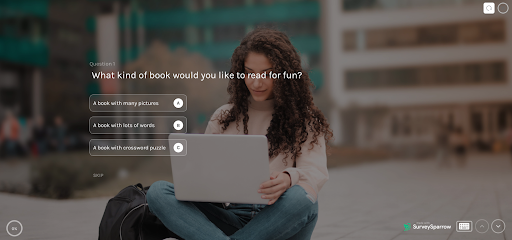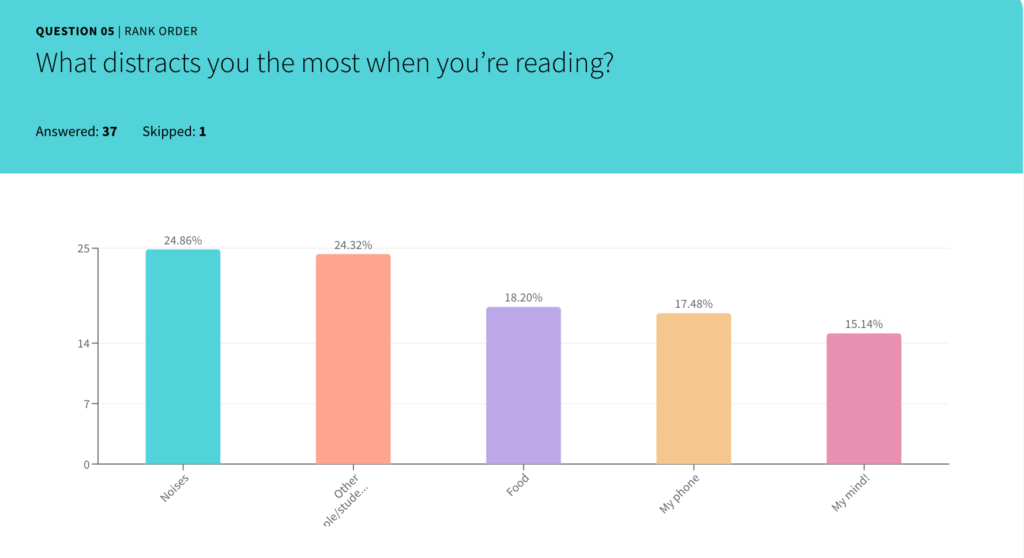Best Of
12 Reading Interest Survey Questions To Ask Students + Sample Questionnaire
Article written by Kate Williams
Product Marketing Manager at SurveySparrow
13 min read
14 October 2024

Looking to learn about your students’ reading preferences? Reading interest surveys can help! Scroll down a bit to find the 12 best reading interest survey questions that will get you the insights you seek.
So what was it? What was the book that made you fall in love with reading? Was it Jane Austen’s? Or Harry Potter? Or Dan Brown’s excellent thrillers?
Not these? Well, we have to admit we’re not solid with our guessing game. But there’s one thing we’re damn good at, according to our clients. Surveys. That’s our thing.
And if you’re an educator looking to build reading habits among students, you’ve come to the right place as we’ll discuss:
- What is a reading interest survey?
- Free reading interest survey templates
- 12 Reading interest survey questions
- Importance of reading interest surveys
- 4 Ways to conduct reading interest surveys
- 8 tips to cultivate a reading habit
Ready with your coffee?
What Is A Reading Interest Survey?
Daniel is a first-grader who said this in his introduction at school –
“Hey, I’m Daniel. My mum calls me Dan. I love to play with my dog, Bozo. I love to draw, and I don’t enjoy reading.”
So Daniel, a.k.a Dan, doesn’t like to read. But his teacher knows reading is essential. And so, she’ll arrange a reading interest survey for Daniel to know why he does not like reading, and what to do about it.
In simple words, reading interest surveys are surveys that let the teacher know about a student’s reading interest. Sometimes, it’s also called a reading interest inventory.
There are a bunch of different questions in this reader’s survey, and the teacher prepares a reading schedule for individual students based on their responses.
Free Reading Interest Survey Templates You Can Use
We understand that you are here to understand what kind of questions to ask to understand the reading interests and habits of your students. But we also know that not all students are the same. This is why we are providing you with three different types of reading interest survey templates.
The following templates are completely free and customizable, so feel free to use it at your convenience.
1. Reading Interest Survey for Elementary School
Discover what your elementary school students love to read and provide them with books or stories they love.
Elementary Student Reading Surveys
Use This Template2. Reading Interest Survey for Middle School
Understand the reading preferences of your middle school students using this template. You can get insights like the genre they are into, their reading habits, favorite authors, and more.
Middle School Student Reading Interest Surveys
Use This Template3. Reading Interest Survey for High School
High school students are more mature and will be interested in more than just stories. Which is why we have created this template for you. The feedback can help you enrich the library and provide more options for students to read from, whether it’s fantasy, non-fiction, or study materials.
High School Student Reading Interest Survey
Use This Template4. General Reader Interest Survey
Here, the audience can be anyone from a school student and college student to working professionals. Use this template to understand your target audience’s reading habits and preference and cater your offerings accordingly.
Book Reading Interest Surveys
Use This TemplateAn alternative is SurveySparrow’s AI Wing. With the power of generative AI, the tool will help you create an entire survey from scratch in seconds. The feature is available to you in the 14-day free trial offered by the tool.
PS: You can make your own, share by email, QR code, or SMS, and track the results. Try SurveySparrow with a free account.
A personalized walkthrough by our experts. No strings attached!
12 Reading Interest Survey Questions + Sample Questionnaire Template
You already know what reading interest surveys are and why they’re crucial. Now, it’s time to discuss the questions to include in these surveys that bring the intended results. From our experience and research, we’ve selected 12 reading interest survey questions.
1. How do you feel about reading?
No reading interest surveys can do well without this question.
It’s one of the first questions educators ask as part of their free reading interest surveys, and it works all the time! Because young students only know how to portray their thoughts directly without sugarcoating them. And that is what’s needed with this question.
So, as an educator or student counselor, if you directly want to get to the point, asking this question would do that.
2. What kind of book would you like to read for fun?
Asking this in your reading interest surveys would bring to light the type of book a student prefers reading.
Now, instead of giving fictional/non-fictional as your options for an elementary student, try giving options like a book with many pictures, a book with lots of words, or a book with crossword puzzles. They’ll be way more interested in choosing from these options.

3. How do you like to spend your free time?
This question would highlight the interest areas of the student, based on which the reading material or books can be selected for them.
4. What’s the best way to study for a test?
Reading the notes or study material on platforms like StuDocu is considered the most efficient way to prepare for a test, and usually, students score high test grades by studying in this way. But if the student chooses other options, you would clearly understand the work required to bring out the reader in them.
With this question, you would be able to separate the occasional readers from the ones who dislike reading.
5. What distracts you the most when you’re reading?
Is it food cravings? Other students? Noises?
Understanding what distracts your students while reading helps in removing those distractions from their environment, which allows them to continue reading and eventually build the reader’s habit.
6. How much time in a day would you prefer reading?
This question should be put in the reading interest surveys of older students – because students who’re not in elementary school would give a more thoughtful and honest answer to this. And based on their answers, you could frame a reading schedule that works and can be followed by them.
We’ve seen our clients building impressive reading schedules based on the answers to this question, and we’re pretty sure you’ll do the same.
7. Apart from school assignments, do you like the reading process?
Including this in the reading interest surveys would give you an idea about how inclined the students are toward reading.
And based on that, their reading programs can be structured.
8. What type of books are you most comfortable reading?
This is where the options of fictional/historical/novel, etc, would come in. As a teacher, this question will let you understand your student’s preferred choice for reading and the type they find interesting.
Mind you, the type of books they’re reading would somewhat affect their personalities as well. So, before helping them with their reading habits, you also need to explain the pros and cons of the different reading material & genres. The answers to this reading interest survey will let you do that.
9. What’s the best book you’ve read so far, and why do you think that?
You’ll get to observe the student’s level of understanding with this survey question.
This question works brilliantly after a reading assignment involving different types of books, as you get to see how well the students are reciprocating to each book’s message.
And based on the reasons they give for their ‘best book’ pick, you’ll be able to suggest books with a similar message to take their reading habit to the next level.
10. How would you choose a book to read?
Would it be from a website or blog recommendation, or parents, friends, or while going through the bookstore?
The way your students choose their books says a lot about their personality and who do they trust the most. This helps you prepare a reading schedule that works all the time.
11. If you won a game or a challenge, what would you choose as the prize?
If you give the option of a ‘pack of books’ here, this question would separate the readers from the rest.
So, you can shift your focus to the ones that love reading by asking this question.
12. Which statement best describes your reading style?
The last question that you should definitely include in reading interest surveys is this. This question would show how much the students know about their reading habits & style.
Based on this, improvements and changes can be made in their reading schedule, if needed. That’s the goal, right? Gradual improvements in your student’s reading habits over time.
To create reader interest surveys using SurveySparrow, you can sign up here for FREE!
A personalized walkthrough by our experts. No strings attached!
A personalized walkthrough by our experts. No strings attached!
Why are Reading Interest Surveys Important?
Reading is awesome. We adults certainly feel that way after spending countless hours reading our favorite books, be it fiction, non-fiction, or autobiographies.
Here, at SurveySparrow, we also have a ‘Share Some Book’ club where all of us exchange books with each other and keep the reading process going. it’s an absolutely fun and enriching process.
But most students don’t think the same about reading, especially the school-going young ones. In fact, some would do anything else apart from reading another page! But all hope is not lost, as not understanding the importance of reading is pretty common among students, which is exactly where reading interest survey questions come in.

4 Ways To Conduct Reading Interest Surveys
Educators have four different options for conducting reading surveys:
- Online surveys
- Paper surveys
- Oral surveys
- Google forms
Let’s dig deep to know more about these.
#1. Online Surveys
With technology, and especially after the COVID-19 pandemic, the entire world has shifted online. Schools are no different, which is why online surveys have been widely used in the past year to conduct reading interest surveys.
From what we’ve observed, this transition was an exciting improvement in the way reading interest survey questions are conducted. It took some time, especially for the young students, to get used to this type of survey. But now things are moving swiftly here, and there’s a chance online surveys might replace paper surveys once and for all!

Create Online Surveys with AI!
A personalized walkthrough by our experts. No strings attached!
#2. Paper Surveys
Conducting paper versions of the reading interest surveys allows for student differentiation easily. It gives the option for younger students and hesitant writers to even draw their answers instead of writing them down.
Paper surveys work well for students from elementary school, as they’re more accustomed to questions being read aloud by the teachers before they can read them themselves and answer.
So, it allows the teacher to give some extra help to the students. It also gives them the option to explain the questions using examples when the students are not sure about what to write.
#3. Oral Surveys
This survey type is used only when the students are extremely reluctant to read and they’re not even willing to read the questions in the survey.
In that case, the teacher says the question out loud with the options, and the students write their answers down on a piece of paper against the question number.
#4. Google Forms
Google Forms gives a very easy and reliable option for teachers to conduct reading interest surveys lately.
While online surveys are more appealing to students and young kids, Google Forms appeals to teachers because of their simplicity and reliability.
The results from the survey are automatically compiled for teachers – so it’s simple. And the teacher doesn’t have to worry about the survey links not working or surveys crashing mid-stage – so it’s reliable! Why won’t a teacher love Google Forms then?
Related Read: How to make a poll on Google Forms
8 Tips To Cultivate A Reading Habit In Students for Life
Over the years, we’ve helped educational institutions and teachers develop the needed habits in their students. And most of them started by working on students’ reading habits, as it paved the way for other positive habits.
Whenever we used to survey or talk to them directly, they were up with stories on how they handled the most difficult of situations and brought the best result out of it to develop the reading habit. Their stories became the tips we want to share with you here.
These tips have come from different institutions and educators, but they all got the intended success from it. We’re hoping that you, too, get similar results. Off we go!
- Encourage curiosity because then, students would want to understand why reading is an important habit to have even when they dislike it.
- Don’t leave questions unanswered if you’re a teacher trying to instill reading habits among young kids. That’ll bring their motivation to learn down.
- Give quick challenges. Students, especially the young ones, learn quickly that way as challenges bring excitement for them.
- Promote healthy competition. It’ll always push the group in the right direction.
- Create and teach students in groups based on similar survey results. You’ll use your energy better, as it’s easier to track the progress of an entire group than of individuals.
- Before giving the students a reading assignment, tell them the summary of the books to read, and keep the ending a mystery!
- Ask students to find 5 (or any number) interesting aspects in a book. It could be the book cover, one of its characters, the ending, etc. This would act as a motivation to read the book properly.
- Before assigning a book to read, explain the topic and genre and give them links to a few articles relating to the topic.
Time For Some Action Now!
Ok, so you’ve read this far, which means you know these four things:
- How crucial reading interest survey questions are for the right development of students.
- What are some time-tested questions to include in these surveys.
- The different ways to conduct such surveys.
- And finally, some tips to cultivate reading habits in students.
What remains now? The start!
You have the right information with you, and the only thing that remains is for you to conduct reading interest surveys using the information you’ve got here. We’re sure you are excited to do that, and we’re just as excited to see you succeed and get the right results.
So, waiting to hear all about your success story. Good luck!
A personalized walkthrough by our experts. No strings attached!
Start 14 Days free trial

Kate Williams
Excels in empowering visionary companies through storytelling and strategic go-to-market planning. With extensive experience in product marketing and customer experience management, she is an accomplished author, podcast host, and mentor, sharing her expertise across diverse platforms and audiences.
Related Articles

Best Of
70+ Mental Health Survey Questions for Students: Your Complete Guide
10 MINUTES
13 May 2024

Best Of
Effective Surveys for Student Engagement: Strategies for Keeping Students Interested
5 MINUTES
3 November 2023

Survey Tips
60 Must-Ask Student Survey Questions With Examples
16 MINUTES
23 January 2024

Customer Experience
Complete Guide to In-App Feedback: Importance & Best Practices
12 MINUTES
20 March 2024
